Graphs of Exponential Functions
As we discussed in the previous section, exponential functions are used for many real-world applications such as finance, forensics, computer science, and most of the life sciences. Working with an equation that describes a real-world situation gives us a method for making predictions. Most of the time, however, the equation itself is not enough. We learn a lot about things by seeing their pictorial representations, and that is exactly why graphing exponential equations is a powerful tool. It gives us another layer of insight for predicting future events.Characteristics of Graphs of Exponential Functions
Before we begin graphing, it is helpful to review the behavior of exponential growth. Recall the table of values for a function of the form [latex]f\left(x\right)={b}^{x}[/latex] whose base is greater than one. We’ll use the function [latex]f\left(x\right)={2}^{x}[/latex]. Observe how the output values in the table below change as the input increases by 1.| x | –3 | –2 | –1 | 0 | 1 | 2 | 3 |
| [latex]f\left(x\right)={2}^{x}[/latex] | [latex]\frac{1}{8}[/latex] | [latex]\frac{1}{4}[/latex] | [latex]\frac{1}{2}[/latex] | 1 | 2 | 4 | 8 |
- the output values are positive for all values of x;
- as x increases, the output values increase without bound; and
- as x decreases, the output values grow smaller, approaching zero.
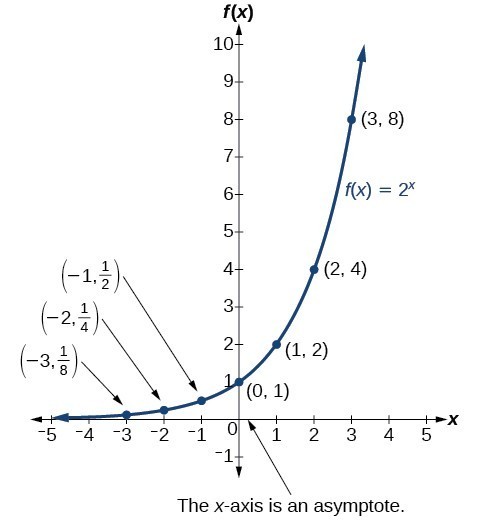 Notice that the graph gets close to the x-axis, but never touches it.
Notice that the graph gets close to the x-axis, but never touches it.| x | –3 | –2 | –1 | 0 | 1 | 2 | 3 |
| [latex]g\left(x\right)=\left(\frac{1}{2}\right)^{x}[/latex] | 8 | 4 | 2 | 1 | [latex]\frac{1}{2}[/latex] | [latex]\frac{1}{4}[/latex] | [latex]\frac{1}{8}[/latex] |
- the output values are positive for all values of x;
- as x increases, the output values grow smaller, approaching zero; and
- as x decreases, the output values grow without bound.
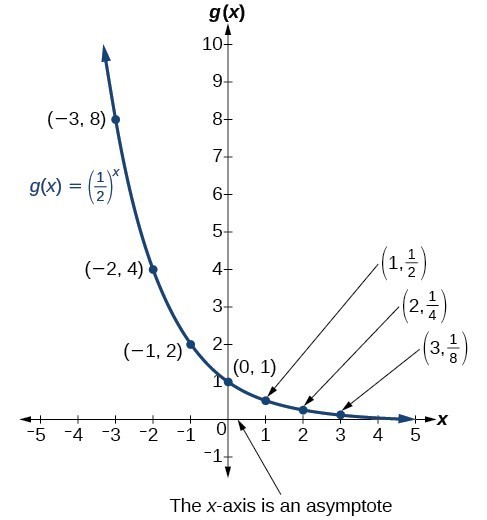 The domain of [latex]g\left(x\right)={\left(\frac{1}{2}\right)}^{x}[/latex] is all real numbers, the range is [latex]\left(0,\infty \right)[/latex], and the horizontal asymptote is [latex]y=0[/latex].
The domain of [latex]g\left(x\right)={\left(\frac{1}{2}\right)}^{x}[/latex] is all real numbers, the range is [latex]\left(0,\infty \right)[/latex], and the horizontal asymptote is [latex]y=0[/latex].A General Note: Characteristics of the Graph of the Parent Function f(x) = bx
An exponential function with the form [latex]f\left(x\right)={b}^{x}[/latex], [latex]b>0[/latex], [latex]b\ne 1[/latex], has these characteristics:- one-to-one function
- horizontal asymptote: [latex]y=0[/latex]
- domain: [latex]\left(-\infty , \infty \right)[/latex]
- range: [latex]\left(0,\infty \right)[/latex]
- x-intercept: none
- y-intercept: [latex]\left(0,1\right)[/latex]
- increasing if [latex]b>1[/latex]
- decreasing if [latex]b<1[/latex]
How To: Given an exponential function of the form [latex]f\left(x\right)={b}^{x}[/latex], graph the function.
- Create a table of points.
- Plot at least 3 point from the table, including the y-intercept [latex]\left(0,1\right)[/latex].
- Draw a smooth curve through the points.
- State the domain, [latex]\left(-\infty ,\infty \right)[/latex], the range, [latex]\left(0,\infty \right)[/latex], and the horizontal asymptote, [latex]y=0[/latex].
Example: Sketching the Graph of an Exponential Function of the Form f(x) = bx
Sketch a graph of [latex]f\left(x\right)={0.25}^{x}[/latex]. State the domain, range, and asymptote.Answer: Before graphing, identify the behavior and create a table of points for the graph.
- Since b = 0.25 is between zero and one, we know the function is decreasing. The left tail of the graph will increase without bound, and the right tail will approach the asymptote y = 0.
- Create a table of points.
x –3 –2 –1 0 1 2 3 [latex]f\left(x\right)={0.25}^{x}[/latex] 64 16 4 1 0.25 0.0625 0.015625 - Plot the y-intercept, [latex]\left(0,1\right)[/latex], along with two other points. We can use [latex]\left(-1,4\right)[/latex] and [latex]\left(1,0.25\right)[/latex].
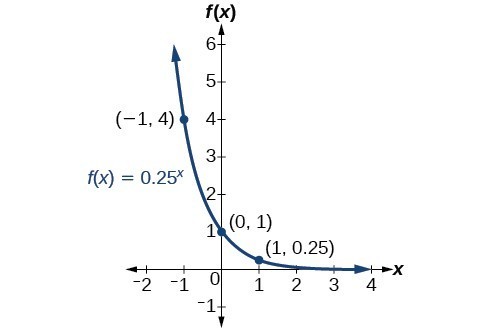 The domain is [latex]\left(-\infty ,\infty \right)[/latex]; the range is [latex]\left(0,\infty \right)[/latex]; the horizontal asymptote is [latex]y=0[/latex].
The domain is [latex]\left(-\infty ,\infty \right)[/latex]; the range is [latex]\left(0,\infty \right)[/latex]; the horizontal asymptote is [latex]y=0[/latex].Try It
Sketch the graph of [latex]f\left(x\right)={4}^{x}[/latex]. State the domain, range, and asymptote.Answer:
The domain is [latex]\left(-\infty ,\infty \right)[/latex]; the range is [latex]\left(0,\infty \right)[/latex]; the horizontal asymptote is [latex]y=0[/latex].

Transformations of exponential graphs behave similarly to those of other functions. Just as with other parent functions, we can apply the four types of transformations—shifts, reflections, stretches, and compressions—to the parent function [latex]f\left(x\right)={b}^{x}[/latex] without loss of shape. For instance, just as the quadratic function maintains its parabolic shape when shifted, reflected, stretched, or compressed, the exponential function also maintains its general shape regardless of the transformations applied.
Graphing a Vertical Shift
The first transformation occurs when we add a constant d to the parent function [latex]f\left(x\right)={b}^{x}[/latex], giving us a vertical shift d units in the same direction as the sign. For example, if we begin by graphing a parent function, [latex]f\left(x\right)={2}^{x}[/latex], we can then graph two vertical shifts alongside it, using [latex]d=3[/latex]: the upward shift, [latex]g\left(x\right)={2}^{x}+3[/latex] and the downward shift, [latex]h\left(x\right)={2}^{x}-3[/latex]. Both vertical shifts are shown in the figure below.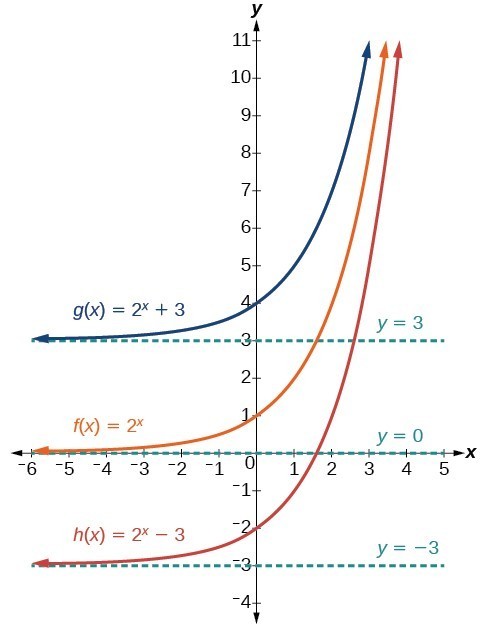 Observe the results of shifting [latex]f\left(x\right)={2}^{x}[/latex] vertically:
Observe the results of shifting [latex]f\left(x\right)={2}^{x}[/latex] vertically:
- The domain, [latex]\left(-\infty ,\infty \right)[/latex] remains unchanged.
- When the function is shifted up 3 units to [latex]g\left(x\right)={2}^{x}+3[/latex]:
- The y-intercept shifts up 3 units to [latex]\left(0,4\right)[/latex].
- The asymptote shifts up 3 units to [latex]y=3[/latex].
- The range becomes [latex]\left(3,\infty \right)[/latex].
- When the function is shifted down 3 units to [latex]h\left(x\right)={2}^{x}-3[/latex]:
- The y-intercept shifts down 3 units to [latex]\left(0,-2\right)[/latex].
- The asymptote also shifts down 3 units to [latex]y=-3[/latex].
- The range becomes [latex]\left(-3,\infty \right)[/latex].
Try it
- Use the slider in the graph below to create a graph of [latex]f(x) = 2^x[/latex] that has been shifted 4 units up. Add a line that represents the horizontal asymptote for this function. What is the equation for this function? What is the new y-intercept? What is it's domain and range?
- Now create a graph of the function [latex]f(x) = 2^x[/latex] that has been shifted down 2 units. Add a line that represents the horizontal asymptote.What is the equation for this function? What is the new y-intercept? What is it's domain and range?
Answer:
- Equation: [latex]f(x) = 2^x+4[/latex], Horizontal Asymptote: [latex]y = 4[/latex], y-intercept: [latex](0,5)[/latex]Domain: [latex](-\infty,\infty)[/latex], Range: [latex](4,\infty)[/latex]
- Equation: [latex]f(x) = 2^x-2[/latex], Horizontal Asymptote: [latex]y = -2[/latex], y-intercept: [latex](0,-1)[/latex]Domain: [latex](-\infty,\infty)[/latex], Range: [latex](-2,\infty)[/latex]
Graphing a Horizontal Shift
The next transformation occurs when we add a constant c to the input of the parent function [latex]f\left(x\right)={b}^{x}[/latex], giving us a horizontal shift c units in the opposite direction of the sign. For example, if we begin by graphing the parent function [latex]f\left(x\right)={2}^{x}[/latex], we can then graph two horizontal shifts alongside it, using [latex]c=3[/latex]: the shift left, [latex]g\left(x\right)={2}^{x+3}[/latex], and the shift right, [latex]h\left(x\right)={2}^{x - 3}[/latex]. Both horizontal shifts are shown in the figure below.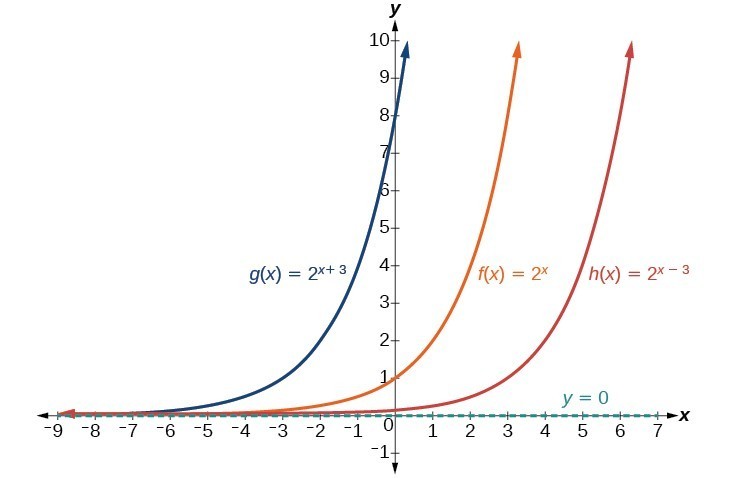 Observe the results of shifting [latex]f\left(x\right)={2}^{x}[/latex] horizontally:
Observe the results of shifting [latex]f\left(x\right)={2}^{x}[/latex] horizontally:
- The domain, [latex]\left(-\infty ,\infty \right)[/latex], remains unchanged.
- The asymptote, [latex]y=0[/latex], remains unchanged.
- The y-intercept shifts such that:
- When the function is shifted left 3 units to [latex]g\left(x\right)={2}^{x+3}[/latex], the y-intercept becomes [latex]\left(0,8\right)[/latex]. This is because [latex]{2}^{x+3}=\left(8\right){2}^{x}[/latex], so the initial value of the function is 8.
- When the function is shifted right 3 units to [latex]h\left(x\right)={2}^{x - 3}[/latex], the y-intercept becomes [latex]\left(0,\frac{1}{8}\right)[/latex]. Again, see that [latex]{2}^{x - 3}=\left(\frac{1}{8}\right){2}^{x}[/latex], so the initial value of the function is [latex]\frac{1}{8}[/latex].
try it
- Use the slider in the graph below to create a graph of [latex]f(x) = 2^x[/latex] that has been shifted 4 units to the right. What is the equation for this function? What is the new y-intercept? What are it's domain and range?
- Use the slider in the graph below to create a graph of [latex]f(x) = 2^x[/latex] that has been shifted 3 units to the left. What is the equation for this function? What is the new y-intercept? What are it's domain and range?
Answer:
- Equation: [latex]f(x) = 2^{x-4}[/latex], y-intercept: [latex](0,\frac{1}{32})[/latex]Domain: [latex](-\infty,\infty)[/latex], Range: [latex](0,\infty)[/latex]
- Equation: [latex]f(x) = 2^{x+3}[/latex], y-intercept: [latex](0,8)[/latex]Domain: [latex](-\infty,\infty)[/latex], Range: [latex](0,\infty)[/latex]
A General Note: Shifts of the Parent Function [latex]f\left(x\right)={b}^{x}[/latex]
For any constants c and d, the function [latex]f\left(x\right)={b}^{x+c}+d[/latex] shifts the parent function [latex]f\left(x\right)={b}^{x}[/latex]- vertically d units, in the same direction of the sign of d.
- horizontally c units, in the opposite direction of the sign of c.
- The y-intercept becomes [latex]\left(0,{b}^{c}+d\right)[/latex].
- The horizontal asymptote becomes y = d.
- The range becomes [latex]\left(d,\infty \right)[/latex].
- The domain, [latex]\left(-\infty ,\infty \right)[/latex], remains unchanged.
How To: Given an exponential function with the form [latex]f\left(x\right)={b}^{x+c}+d[/latex], graph the translation.
- Draw the horizontal asymptote y = d.
- Identify the shift as [latex]\left(-c,d\right)[/latex]. Shift the graph of [latex]f\left(x\right)={b}^{x}[/latex] left c units if c is positive, and right [latex]c[/latex] units if c is negative.
- Shift the graph of [latex]f\left(x\right)={b}^{x}[/latex] up d units if d is positive, and down d units if d is negative.
- State the domain, [latex]\left(-\infty ,\infty \right)[/latex], the range, [latex]\left(d,\infty \right)[/latex], and the horizontal asymptote [latex]y=d[/latex].
Example: Graphing a Shift of an Exponential Function
Graph [latex]f\left(x\right)={2}^{x+1}-3[/latex]. State the domain, range, and asymptote.Answer: We have an exponential equation of the form [latex]f\left(x\right)={b}^{x+c}+d[/latex], with [latex]b=2[/latex], [latex]c=1[/latex], and [latex]d=-3[/latex]. Draw the horizontal asymptote [latex]y=d[/latex], so draw [latex]y=-3[/latex]. Identify the shift as [latex]\left(-c,d\right)[/latex], so the shift is [latex]\left(-1,-3\right)[/latex].
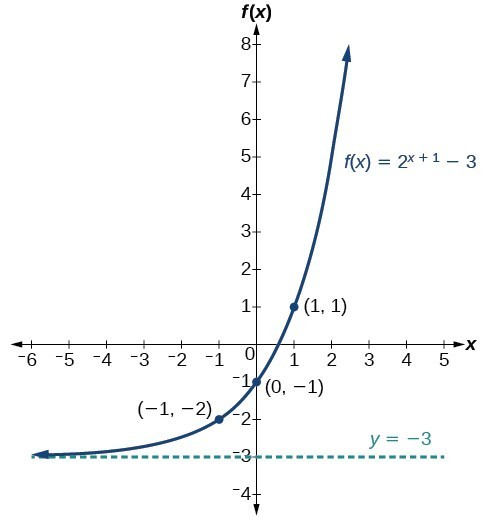 The domain is [latex]\left(-\infty ,\infty \right)[/latex]; the range is [latex]\left(-3,\infty \right)[/latex]; the horizontal asymptote is [latex]y=-3[/latex].
The domain is [latex]\left(-\infty ,\infty \right)[/latex]; the range is [latex]\left(-3,\infty \right)[/latex]; the horizontal asymptote is [latex]y=-3[/latex].Try It
Use the sliders in the graph below to create a graph of the function [latex]f\left(x\right)={2}^{x - 1}+3[/latex]. State domain, range, and asymptote. https://www.desmos.com/calculator/e5l4eca3obAnswer:
The domain is [latex]\left(-\infty ,\infty \right)[/latex]; the range is [latex]\left(3,\infty \right)[/latex]; the horizontal asymptote is y = 3.
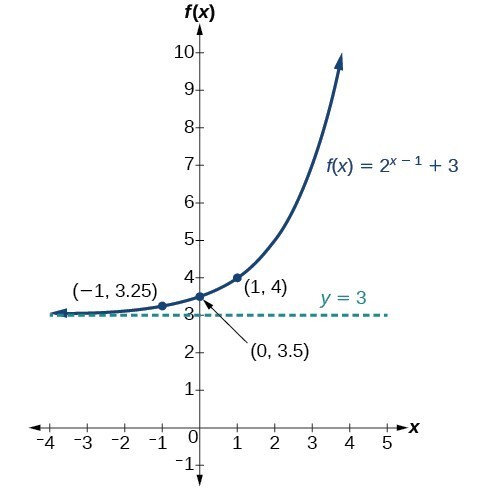
Use a Graph to Approximate a Solution to an Exponential Equation
Graphing can help you confirm or find the solution to an exponential equation. An exponential equation is different from a function because a function is a large collection of points made of inputs and corresponding outputs, whereas equations that you have seen typically have one, two, or no solutions. For example, [latex]f(x)=2^{x}[/latex] is a function and is comprised of many points [latex](x,f(x))[/latex], and [latex]4=2^{x}[/latex] can be solved to find the specific value for x that makes it a true statement. The graph below shows the intersection of the line [latex]f(x)=4[/latex], and [latex]f(x)=2^{x}[/latex], you can see they cross at [latex]y=4[/latex]. https://www.desmos.com/calculator/lhmpdkbjt0 In the next example, you can try this for yourself.Example : Approximating the Solution of an Exponential Equation
Use Desmos to solve [latex]42=1.2{\left(5\right)}^{x}+2.8[/latex] graphically.Answer: First, graph the function [latex]f(x)=1.2{\left(5\right)}^{x}+2.8[/latex] , then add another function [latex]f(x) = 42[/latex]. Desmos automatically calculates points of interest including intersections. Essentially, you are looking for the intersection of two functions. Click on the point of intersection, and you will see the the x and y values for the point. Your graph will look like this: https://www.desmos.com/calculator/ozaejvejqn
Try It
Solve [latex]4=7.85{\left(1.15\right)}^{x}-2.27[/latex] graphically. Round to the nearest thousandth.Answer: [latex]x\approx -1.608[/latex]
Stretch, Compress, or Reflect an Exponential Function
While horizontal and vertical shifts involve adding constants to the input or to the function itself, a stretch or compression occurs when we multiply the parent function [latex]f\left(x\right)={b}^{x}[/latex] by a constant [latex]|a|>0[/latex]. For example, if we begin by graphing the parent function [latex]f\left(x\right)={2}^{x}[/latex], we can then graph the stretch, using [latex]a=3[/latex], to get [latex]g\left(x\right)=3{\left(2\right)}^{x}[/latex] as shown on the left in Figure 8, and the compression, using [latex]a=\frac{1}{3}[/latex], to get [latex]h\left(x\right)=\frac{1}{3}{\left(2\right)}^{x}[/latex] as shown on the right in the figure below.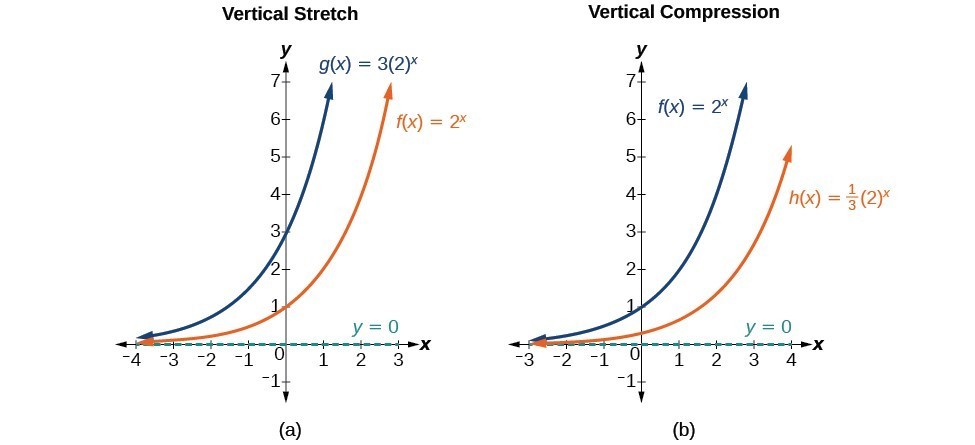 (a) [latex]g\left(x\right)=3{\left(2\right)}^{x}[/latex] stretches the graph of [latex]f\left(x\right)={2}^{x}[/latex] vertically by a factor of 3. (b) [latex]h\left(x\right)=\frac{1}{3}{\left(2\right)}^{x}[/latex] compresses the graph of [latex]f\left(x\right)={2}^{x}[/latex] vertically by a factor of [latex]\frac{1}{3}[/latex].
(a) [latex]g\left(x\right)=3{\left(2\right)}^{x}[/latex] stretches the graph of [latex]f\left(x\right)={2}^{x}[/latex] vertically by a factor of 3. (b) [latex]h\left(x\right)=\frac{1}{3}{\left(2\right)}^{x}[/latex] compresses the graph of [latex]f\left(x\right)={2}^{x}[/latex] vertically by a factor of [latex]\frac{1}{3}[/latex].A General Note: Stretches and Compressions of the Parent Function f(x) = bx
For any factor a > 0, the function [latex]f\left(x\right)=a{\left(b\right)}^{x}[/latex]- is stretched vertically by a factor of a if [latex]|a|>1[/latex].
- is compressed vertically by a factor of a if [latex]|a|<1[/latex].
- has a y-intercept of [latex]\left(0,a\right)[/latex].
- has a horizontal asymptote at [latex]y=0[/latex], a range of [latex]\left(0,\infty \right)[/latex], and a domain of [latex]\left(-\infty ,\infty \right)[/latex], which are unchanged from the parent function.
Example: Graphing the Stretch of an Exponential Function
Sketch a graph of [latex]f\left(x\right)=4{\left(\frac{1}{2}\right)}^{x}[/latex]. State the domain, range, and asymptote.Answer: Before graphing, identify the behavior and key points on the graph.
- Since [latex]b=\frac{1}{2}[/latex] is between zero and one, the left tail of the graph will increase without bound as x decreases, and the right tail will approach the x-axis as x increases.
- Since a = 4, the graph of [latex]f\left(x\right)={\left(\frac{1}{2}\right)}^{x}[/latex] will be stretched by a factor of 4.
- Create a table of points.
x –3 –2 –1 0 1 2 3 [latex]f\left(x\right)=4\left(\frac{1}{2}\right)^{x}[/latex] 32 16 8 4 2 1 0.5 - Plot the y-intercept, [latex]\left(0,4\right)[/latex], along with two other points. We can use [latex]\left(-1,8\right)[/latex] and [latex]\left(1,2\right)[/latex].
- Draw a smooth curve connecting the points.
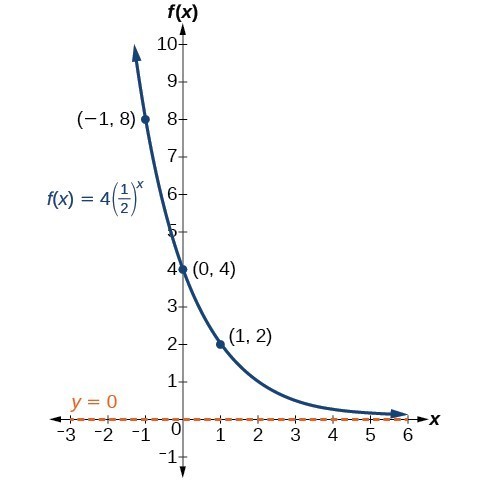 The domain is [latex]\left(-\infty ,\infty \right)[/latex]; the range is [latex]\left(0,\infty \right)[/latex]; the horizontal asymptote is y = 0.
The domain is [latex]\left(-\infty ,\infty \right)[/latex]; the range is [latex]\left(0,\infty \right)[/latex]; the horizontal asymptote is y = 0.Try It
Use the sliders in the graph below to sketch the graph of [latex]f\left(x\right)=\frac{1}{2}{\left(4\right)}^{x}[/latex]. State the domain, range, and asymptote. https://www.desmos.com/calculator/u8kysdu1wlAnswer: The domain is [latex]\left(-\infty ,\infty \right)[/latex]; the range is [latex]\left(0,\infty \right)[/latex]; the horizontal asymptote is [latex]y=0[/latex].

Graphing Reflections
In addition to shifting, compressing, and stretching a graph, we can also reflect it about the x-axis or the y-axis. When we multiply the parent function [latex]f\left(x\right)={b}^{x}[/latex] by –1, we get a reflection about the x-axis. When we multiply the input by –1, we get a reflection about the y-axis. For example, if we begin by graphing the parent function [latex]f\left(x\right)={2}^{x}[/latex], we can then graph the two reflections alongside it. The reflection about the x-axis, [latex]g\left(x\right)={-2}^{x}[/latex], is shown on the left side, and the reflection about the y-axis [latex]h\left(x\right)={2}^{-x}[/latex], is shown on the right side.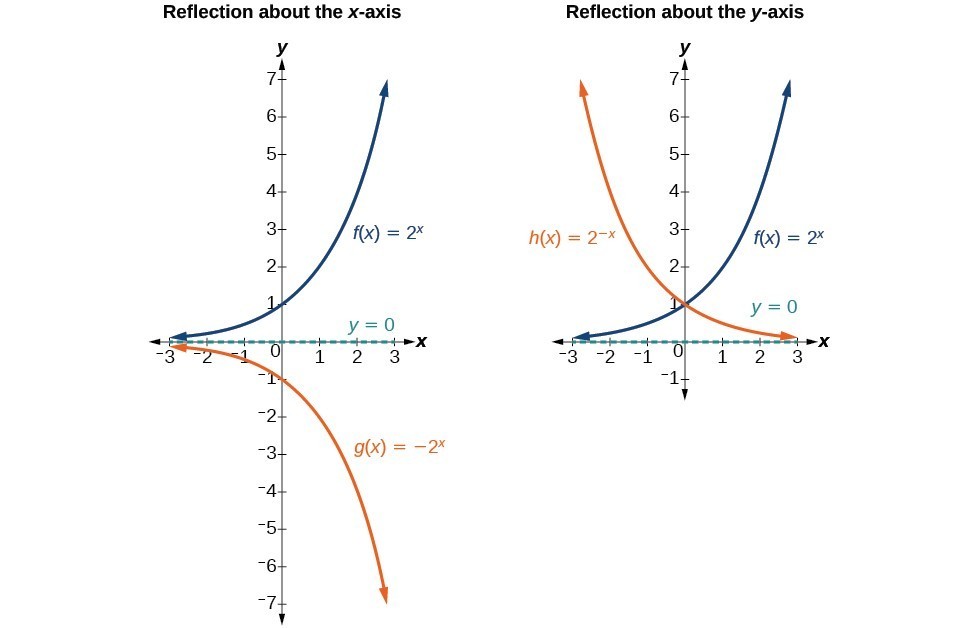 (a) [latex]g\left(x\right)=-{2}^{x}[/latex] reflects the graph of [latex]f\left(x\right)={2}^{x}[/latex] about the x-axis. (b) [latex]g\left(x\right)={2}^{-x}[/latex] reflects the graph of [latex]f\left(x\right)={2}^{x}[/latex] about the y-axis.
(a) [latex]g\left(x\right)=-{2}^{x}[/latex] reflects the graph of [latex]f\left(x\right)={2}^{x}[/latex] about the x-axis. (b) [latex]g\left(x\right)={2}^{-x}[/latex] reflects the graph of [latex]f\left(x\right)={2}^{x}[/latex] about the y-axis.A General Note: Reflections of the Parent Function f(x) = bx
The function [latex]f\left(x\right)=-{b}^{x}[/latex]- reflects the parent function [latex]f\left(x\right)={b}^{x}[/latex] about the x-axis.
- has a y-intercept of [latex]\left(0,-1\right)[/latex].
- has a range of [latex]\left(-\infty ,0\right)[/latex]
- has a horizontal asymptote at [latex]y=0[/latex] and domain of [latex]\left(-\infty ,\infty \right)[/latex], which are unchanged from the parent function.
- reflects the parent function [latex]f\left(x\right)={b}^{x}[/latex] about the y-axis.
- has a y-intercept of [latex]\left(0,1\right)[/latex], a horizontal asymptote at [latex]y=0[/latex], a range of [latex]\left(0,\infty \right)[/latex], and a domain of [latex]\left(-\infty ,\infty \right)[/latex], which are unchanged from the parent function.
Example: Writing and Graphing the Reflection of an Exponential Function
Find and graph the equation for a function, [latex]g\left(x\right)[/latex], that reflects [latex]f\left(x\right)={\left(\frac{1}{4}\right)}^{x}[/latex] about the x-axis. State its domain, range, and asymptote.Answer: Since we want to reflect the parent function [latex]f\left(x\right)={\left(\frac{1}{4}\right)}^{x}[/latex] about the x-axis, we multiply [latex]f\left(x\right)[/latex] by –1 to get, [latex]g\left(x\right)=-{\left(\frac{1}{4}\right)}^{x}[/latex]. Next we create a table of points.
| [latex]x[/latex] | –3 | –2 | –1 | 0 | 1 | 2 | 3 |
| [latex]g\left(x\right)=-\left(\frac{1}{4}\right)^{x}[/latex] | –64 | –16 | –4 | –1 | –0.25 | –0.0625 | –0.0156 |
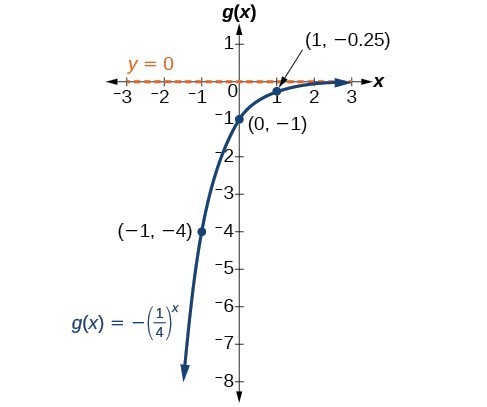 The domain is [latex]\left(-\infty ,\infty \right)[/latex]; the range is [latex]\left(-\infty ,0\right)[/latex]; the horizontal asymptote is [latex]y=0[/latex].
The domain is [latex]\left(-\infty ,\infty \right)[/latex]; the range is [latex]\left(-\infty ,0\right)[/latex]; the horizontal asymptote is [latex]y=0[/latex].Try It
Use Desmos to graph the equation for a function, [latex]g\left(x\right)[/latex], that reflects [latex]f\left(x\right)={1.25}^{x}[/latex] about the y-axis. State its domain, range, and asymptote.Answer:
The domain is [latex]\left(-\infty ,\infty \right)[/latex]; the range is [latex]\left(0,\infty \right)[/latex]; the horizontal asymptote is [latex]y=0[/latex].

Summarizing Translations of the Exponential Function
Now that we have worked with each type of translation for the exponential function, we can summarize them to arrive at the general equation for translating exponential functions.| Translations of the Parent Function [latex]f\left(x\right)={b}^{x}[/latex] | |
|---|---|
| Translation | Form |
Shift
|
[latex]f\left(x\right)={b}^{x+c}+d[/latex] |
Stretch and Compress
|
[latex]f\left(x\right)=a{b}^{x}[/latex] |
| Reflect about the x-axis | [latex]f\left(x\right)=-{b}^{x}[/latex] |
| Reflect about the y-axis | [latex]f\left(x\right)={b}^{-x}={\left(\frac{1}{b}\right)}^{x}[/latex] |
| General equation for all translations | [latex]f\left(x\right)=a{b}^{x+c}+d[/latex] |
A General Note: Translations of Exponential Functions
A translation of an exponential function has the form [latex-display] f\left(x\right)=a{b}^{x+c}+d[/latex-display] Where the parent function, [latex]y={b}^{x}[/latex], [latex]b>1[/latex], is- shifted horizontally c units to the left.
- stretched vertically by a factor of |a| if |a| > 0.
- compressed vertically by a factor of |a| if 0 < |a| < 1.
- shifted vertically d units.
- reflected about the x-axis when a < 0.
Example: Writing a Function from a Description
Write the equation for the function described below. Give the horizontal asymptote, the domain, and the range.- [latex]f\left(x\right)={e}^{x}[/latex] is vertically stretched by a factor of 2, reflected across the y-axis, and then shifted up 4 units.
Answer: We want to find an equation of the general form [latex] f\left(x\right)=a{b}^{x+c}+d[/latex]. We use the description provided to find a, b, c, and d.
- We are given the parent function [latex]f\left(x\right)={e}^{x}[/latex], so b = e.
- The function is stretched by a factor of 2, so a = 2.
- The function is reflected about the y-axis. We replace x with –x to get: [latex]{e}^{-x}[/latex].
- The graph is shifted vertically 4 units, so d = 4.
[latex]\begin{array} f\left(x\right)\hfill & =a{b}^{x+c}+d\hfill \\ \hfill & =2{e}^{-x+0}+4\hfill \\ \hfill & =2{e}^{-x}+4\hfill \end{array}[/latex]
The domain is [latex]\left(-\infty ,\infty \right)[/latex]; the range is [latex]\left(4,\infty \right)[/latex]; the horizontal asymptote is [latex]y=4[/latex].Try It
Write the equation for function described below. Give the horizontal asymptote, the domain, and the range.- [latex]f\left(x\right)={e}^{x}[/latex] is compressed vertically by a factor of [latex]\frac{1}{3}[/latex], reflected across the x-axis and then shifted down 2 units.
Answer: [latex]f\left(x\right)=-\frac{1}{3}{e}^{x}-2[/latex]; the domain is [latex]\left(-\infty ,\infty \right)[/latex]; the range is [latex]\left(-\infty ,2\right)[/latex]; the horizontal asymptote is [latex]y=2[/latex].
Key Equations
| General Form for the Translation of the Parent Function [latex]\text{ }f\left(x\right)={b}^{x}[/latex] | [latex]f\left(x\right)=a{b}^{x+c}+d[/latex] |
Key Concepts
- The graph of the function [latex]f\left(x\right)={b}^{x}[/latex] has a y-intercept at [latex]\left(0, 1\right)[/latex], domain [latex]\left(-\infty , \infty \right)[/latex], range [latex]\left(0, \infty \right)[/latex], and horizontal asymptote [latex]y=0[/latex].
- If [latex]b>1[/latex], the function is increasing. The left tail of the graph will approach the asymptote [latex]y=0[/latex], and the right tail will increase without bound.
- If 0 < b < 1, the function is decreasing. The left tail of the graph will increase without bound, and the right tail will approach the asymptote [latex]y=0[/latex].
- The equation [latex]f\left(x\right)={b}^{x}+d[/latex] represents a vertical shift of the parent function [latex]f\left(x\right)={b}^{x}[/latex].
- The equation [latex]f\left(x\right)={b}^{x+c}[/latex] represents a horizontal shift of the parent function [latex]f\left(x\right)={b}^{x}[/latex].
- Approximate solutions of the equation [latex]f\left(x\right)={b}^{x+c}+d[/latex] can be found using a graphing calculator.
- The equation [latex]f\left(x\right)=a{b}^{x}[/latex], where [latex]a>0[/latex], represents a vertical stretch if [latex]|a|>1[/latex] or compression if [latex]0<|a|<1[/latex] of the parent function [latex]f\left(x\right)={b}^{x}[/latex].
- When the parent function [latex]f\left(x\right)={b}^{x}[/latex] is multiplied by –1, the result, [latex]f\left(x\right)=-{b}^{x}[/latex], is a reflection about the x-axis. When the input is multiplied by –1, the result, [latex]f\left(x\right)={b}^{-x}[/latex], is a reflection about the y-axis.
- All translations of the exponential function can be summarized by the general equation [latex]f\left(x\right)=a{b}^{x+c}+d[/latex].
- Using the general equation [latex]f\left(x\right)=a{b}^{x+c}+d[/latex], we can write the equation of a function given its description.
Licenses & Attributions
CC licensed content, Original
- Revision and Adaptation. Provided by: Lumen Learning License: CC BY: Attribution.
- Characteristics of Graphs of Exponential Functions Interactive. Authored by: Lumen Learning. Located at: https://www.desmos.com/calculator/3pqyjsunkg. License: Public Domain: No Known Copyright.
- Horizontal and Vertical Translations of Exponential Functions Interactive. Authored by: Lumen Learning. Located at: https://www.desmos.com/calculator/5mrjqegkxk. License: Public Domain: No Known Copyright.
- Horizontal and Vertical Translations of Exponential Functions 2 Interactive. Authored by: Lumen Learning. Located at: https://www.desmos.com/calculator/rpv1kea0pz. License: Public Domain: No Known Copyright.
- Horizontal and Vertical Translations of Exponential Functions 3 Interactive. Authored by: Lumen Learning. Located at: https://www.desmos.com/calculator/e5l4eca3ob. License: Public Domain: No Known Copyright.
- Horizontal and Vertical Translations of Exponential Functions 4 Interactive. Authored by: Lumen Learning. Located at: https://www.desmos.com/calculator/ozaejvejqn. License: Public Domain: No Known Copyright.
- Solve Exponential Interactive. Authored by: Lumen Learning. Located at: https://www.desmos.com/calculator/lhmpdkbjt0. License: Public Domain: No Known Copyright.
CC licensed content, Shared previously
- Precalculus. Provided by: OpenStax Authored by: Jay Abramson, et al.. Located at: https://openstax.org/books/precalculus/pages/1-introduction-to-functions. License: CC BY: Attribution. License terms: Download For Free at : http://cnx.org/contents/[email protected]..
- College Algebra. Provided by: OpenStax Authored by: Abramson, Jay et al.. License: CC BY: Attribution. License terms: Download for free at http://cnx.org/contents/[email protected].
- Question ID 63064. Authored by: Brin, Leon. License: CC BY: Attribution. License terms: IMathAS Community License, CC-BY + GPL.
- Question ID 129498. Authored by: Day, Alyson. License: CC BY: Attribution. License terms: IMathAS Community License CC-BY + GPL.
